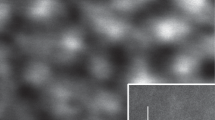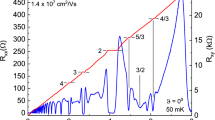Abstract
States in the AlAs/GaAs(12)/AlAs(110) quantum well and AlAs(6)/GaAs(12)(110) superlattice are considered. For analysis of mixing of light- and heavy-hole states in these structures, a parameter-dependent set of basis functions is suggested and the values of the parameter at which one of the functions describes basically heavy-hole states and the other light-hole states are determined. For the energy region considered in the study, four energy levels are determined in the AlAs/GaAs(12)/AlAs(110) quantum well and, correspondingly, four minibands in the AlAs(6)/GaAs(12)(110) superlattice. Analysis shows that the first and fourth levels in the quantum well and the first and fourth minibands in the superlattice are related basically to heavy-hole states. The other two states in the quantum well and the second and third minibands in the super-lattice are structurally more complex: in these states and minibands, the hole states are noticeably mixed. In these minibands, states are substantially separated in space and in spin.
Similar content being viewed by others
References
J. Xia, Phys. Rev. B 43, 9856 (1991).
S. Nojima, Phys. Rev. B 47, 13535 (1993).
Y. Kajikawa, Phys. Rev. B 51, 16790 (1995).
G. F. Karavaev, V. N. Chernyshev, and R. M. Egunov, Fiz. Tekh. Poluprovodn. 37, 592 (2003) [Semiconductors 37, 573 (2003)].
Y. Kajikawa, N. Nishimoto, and Y. Higuchi, Phys. Rev. B 69, 205320 (2004).
S. Dohrmann, D. Hagele, J. Rudolph, M. Bichler, D. Schuh, and M. Oestreich, Phys. Rev. Lett. 93, 147405 (2004).
G. F. Karavaev and V. N. Chernyshov, Izv. Vyssh. Uchebn. Zaved., Ser. Fiz., No. 6, 51 (2003).
G. F. Karavaev and V. N. Chernyshov, Fiz. Tekh. Poluprovodn. 40, 549 (2006) [Semiconductors 40, 534 (2006)].
G. F. Karavaev and V. N. Chernyshov, Fiz. Tekh. Poluprovodn. 35, 841 (2001) [Semiconductors 35, 807 (2001)].
G. F. Karavaev, V. N. Chernyshov, and R. M. Egunov, Fiz. Tekh. Poluprovodn. 36, 558 (2002) [Semiconductors 36, 527 (2002)].
Author information
Authors and Affiliations
Corresponding author
Additional information
Original Russian Text © V.N. Chernyshov, 2010, published in Fizika i Tekhnika Poluprovodnikov, 2010, Vol. 44, No. 10, pp. 1345–1351.
Rights and permissions
About this article
Cite this article
Chernyshov, V.N. Mixing of hole states in GaAs/AlAs(110) heterostructures. Semiconductors 44, 1301–1307 (2010). https://doi.org/10.1134/S1063782610100118
Received:
Accepted:
Published:
Issue Date:
DOI: https://doi.org/10.1134/S1063782610100118




